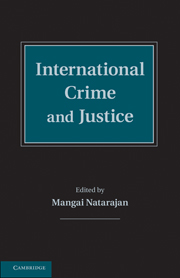Book contents
- Frontmatter
- Contents
- List of Figures
- List of Tables
- List of Contributors
- Foreword
- Preface
- Introduction
- Part I International Criminology
- Part II Law, Punishment, and Crime Control Philosophies of the World
- Part III Transnational Crime
- Part IV Organized Crime and Terrorism
- Part V International crime
- Part VI Delivering International Justice
- Part VII International Cooperation and Criminal Justice
- Part VIII International Research and Crime Statistics
- 60 The U.S. Uniform Crime Reports and the National Crime Victimization Survey
- 61 Highlights of the International Crime Victims Survey
- 62 Crossnational Comparisons Based on Official Statistics of Crime
- 63 The International Self-Report Delinquency Study (ISRD)
- 64 Criminology, Method, and Qualitative Comparative Analysis
- Part IX International research resources
- World Map
- Index
- References
63 - The International Self-Report Delinquency Study (ISRD)
Published online by Cambridge University Press: 05 October 2014
- Frontmatter
- Contents
- List of Figures
- List of Tables
- List of Contributors
- Foreword
- Preface
- Introduction
- Part I International Criminology
- Part II Law, Punishment, and Crime Control Philosophies of the World
- Part III Transnational Crime
- Part IV Organized Crime and Terrorism
- Part V International crime
- Part VI Delivering International Justice
- Part VII International Cooperation and Criminal Justice
- Part VIII International Research and Crime Statistics
- 60 The U.S. Uniform Crime Reports and the National Crime Victimization Survey
- 61 Highlights of the International Crime Victims Survey
- 62 Crossnational Comparisons Based on Official Statistics of Crime
- 63 The International Self-Report Delinquency Study (ISRD)
- 64 Criminology, Method, and Qualitative Comparative Analysis
- Part IX International research resources
- World Map
- Index
- References
Summary
BACKGROUND
The self-report method has gained widespread use among researchers, both in the United States and abroad (Junger-Tas & Marshall, 1999; Klein, 1989). The International Self-Report Delinquency Study (ISRD) is a large internationally collaborative self-report study of delinquency, victimization, and substance use of twelve to fifteen year old pupils in grades seven, eight, and nine. The ISRD project was developed to respond to the need for standardized, internationally comparable data on youth crime. International comparisons of survey data may only be made if all countries use the same (translated) questionnaires, and use comparable methods in questionnaire administration, sample selection, and data coding. The first ISRD study (1991–2) pioneered the use of standardized international self-report methodology on youth in thirteen countries (Junger-Tas et al., 2003). Fifteen years later, the study was repeated, this time with a larger number of countries and an expanded questionnaire (ISRD-2) (Junger-Tas et al., 2010). A third and larger ISRD study is planned for 2011–12. This chapter discusses the ISRD-2.
ISRD-2
The main objectives of the project are to study crossnational variability as well as international trends in juvenile delinquency, substance use and victimization over time; to improve standardized self-report methodology for comparative purposes, and to generally advance comparative criminological research beyond the constraints of officially recorded crime. Official crime rates do not lead to valid international comparison, due to variations in crime definitions and in prosecution policies. Moreover, unlike official data, self-reports provide background information needed to test criminological theory (Junger-Tas & Marshall, 1999). The ISRD-2 aims to estimate the prevalence and incidence of youthful offending, substance use and victimization, as well as to examine the correlates of youth crime and to test different explanations of crime in thirty-one countries. The study also collects city- and country-level indicators.
- Type
- Chapter
- Information
- International Crime and Justice , pp. 478 - 485Publisher: Cambridge University PressPrint publication year: 2010
References
- 1
- Cited by

